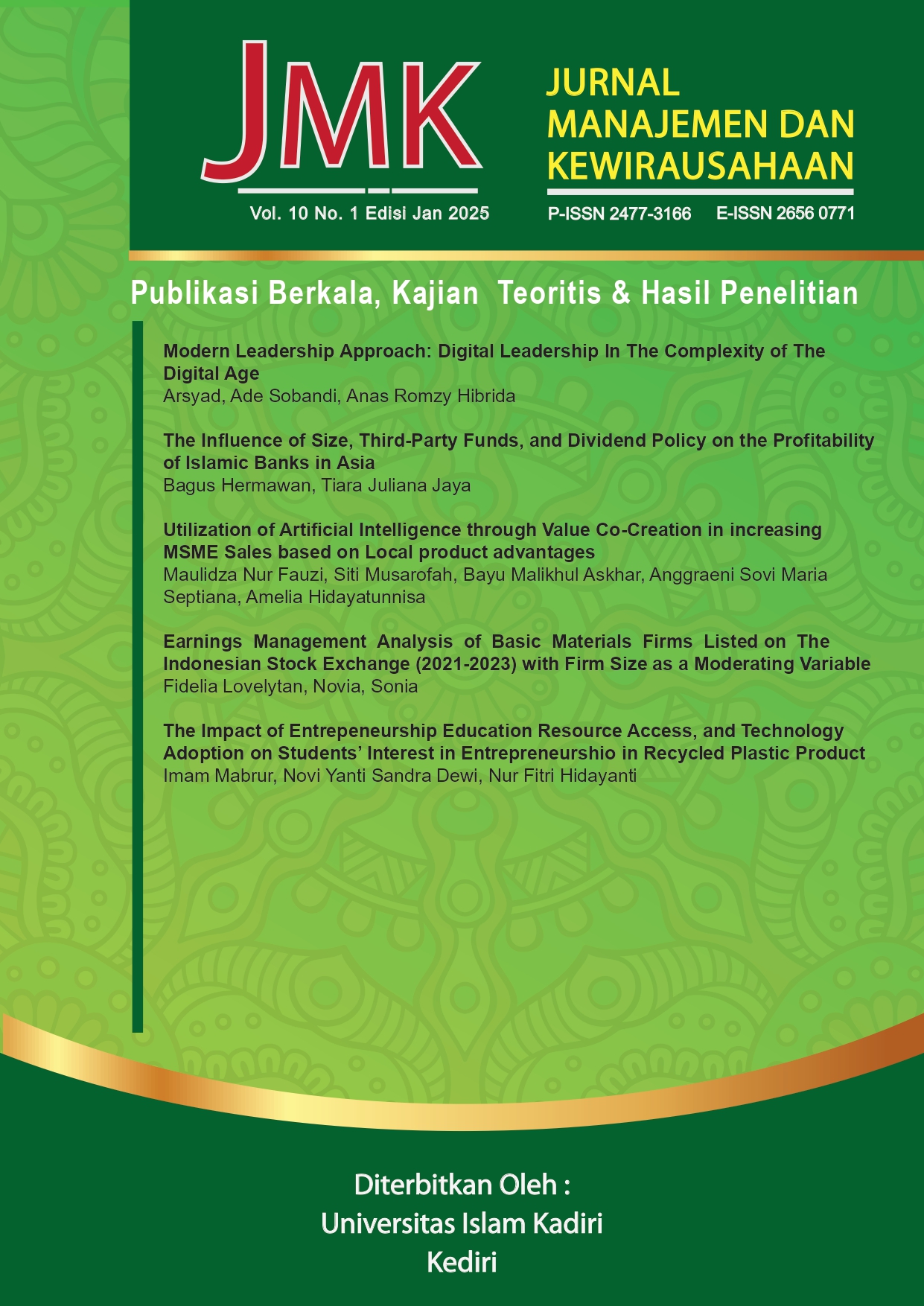The Influence of Size, Third-Party Funds, and Dividend Policy on the Profitability of Islamic Banks in Asia
Abstract
This study aims to analyze the impact of bank size, third-party funds (TPF), and dividend policy on the profitability of Islamic banks in Asia. The study population consists of the 128 largest Islamic banks in the world that are listed and publish annual financial reports for the period 2019-2023, and the sample includes 15 Islamic banks from 11 countries in Asia with the largest assets. The sampling technique used is purposive sampling. The analysis method employed is panel regression, using EViews 10 software. The results indicate that bank size has a positive and significant impact on profitability, TPF has a negative and significant impact, while dividend policy does not have a significant effect on profitability. These findings provide important implications for fund management, increasing economies of scale, and resource allocation to support the sustainable growth of the Islamic banking industry in Asia.
References
Ali, M. M., Hariyati, T., Pratiwi, M. Y., and Afifah, S. (2022). Metodologi Penelitian Kuantitatif dan Penerapannya dalam Penelitian. Education Journal.2022, 2(2), 1–6.
Ana, D. E., and Zunaidi, A. (2022). Strategi Perbankan Syariah Dalam Memenangkan Persaingan Di Masa Pandemi Covid-19. Proceedings of Islamic Economics, Business, and Philanthropy, 1(1), 167–188.
Ardheta, P. A., and Sina, H. R. (2020). Pengaruh Capital Adequacy Ratio, Dana Pihak Ketiga, Non Performing Financing dan Pembiayaan Murabahah Terhadap Profitabilitas. Jurnal Akuntansi Dan Manajemen, 17(02), 32–38. https://doi.org/10.36406/jam.v17i02.328
Belianti, L., Ruhadi, R., and Setiawan, S. (2022). Pengaruh Indeks Maqashid Syariah dan Ukuran Perusahaan terhadap Profitabilitas. Indonesian Journal of Economics and Management, 2(2), 441–451. https://doi.org/10.35313/ijem.v2i2.3692
Budi Gautama Siregar. (2021). Dana Pihak Ketiga Pada Perbankan Syariah Di Indonesia. Jurnal Penelitian Ekonomi Akuntansi (JENSI), 5(2), 111–121. https://doi.org/10.33059/jensi.v5i2.3995
Damayanti, A. C., and Mawardi, W. (2022). Pengaruh Ukuran Bank (Size), Loans to Deposit Ratio (LDR), Capital Adequacy Ratio (CAR), Non-Performing Loans (NPL), Diversifikasi Pendapatan, dan BOPO Terhadap Kinerja Bank di Indonesia (Studi Pada Bank Umum Konvensional yang Terdaftar di BEI Tahun 2016-. Diponegoro Journal of Management, 11(1), 1–13.
Ghozali, M., Azmi, M. U., and Nugroho, W. (2019). Perkembangan Bank Syariah Di Asia Tenggara: Sebuah Kajian Historis. Falah: Jurnal Ekonomi Syariah, 4(1), 44. https://doi.org/10.22219/jes.v4i1.8700
Hendari, S., Arifin, Z., Yulius, Y., and Hidayat, M. (2024). Penilaian Aspek Profitabilitas pada Bank yang Tercatat di Bursa Efek Indonesia Aspects of Profitability Determinants in Banking Listed on the Indonesia Stock Exchange. 11, 23–36. https://doi.org/10.55963/jumpa.v11i1.604
Henny, L. A. (2017). Pengaruh Kebijakan Dividen, Leverage dan Pertumbuhan Penjualan Terhadap Profitabilitas Pada Masa yang Akan Datang. Jurnal Akuntansi AKUNESA, 5(3), 43–68.
Hidayat, A., and Sunarsi, D. (2020). Faktor-Faktor Yang Mempengaruhi Dana Pihak Ketiga Dan Dampaknya Terhadap Profitabilitas. Jurnal Proaksi, 1, 1–12.
Islamiah, I. N., Nurnasrina, Salman, N. F. B., and Huda, N. (2024). Transformasi Digital Pada Perbankan Syariah Indonesia: Produk IT Dan Jenis Transaksi. Sharing: Journal Of Islamic Economics, Management, and Business, 3(1), 91–104.
Islamic finance development report. (2021). Islamic finance development report 2021: Advancing economies. Refinitiv: An LSEG Business, 78.
Liana Susanto, L. P. (2019). Faktor Yang Mempengaruhi Profitabilitas Pada Perbankan Yang Terdaftar Di Bei. Jurnal Paradigma Akuntansi, 1(2), 282. https://doi.org/10.24912/jpa.v1i2.4701
Maula, I., and Jaya, T. J. (2022). Effect of Earning Asset Quality, Financial Leverage, and Company Size on Financial Performance of Sharia Commercial Banks. Jurnal Masharif Al-Syariah: Jurnal Ekonomi Dan Perbankan Syariah, 7(2), 763–775.
Mei, V. N., Periode, P., Anatasya, A., and Susilowati, E. (2021). Pengaruh Bank Size , Nim , Dan Car Terhadap. 1(1), 271–281.
Modal, P. S., Dan, K. D., and Candradewi, M. R. (2019). LIKUIDITAS TERHADAP PROFITABILITAS PERUSAHAAN PERBANKAN DI BURSA EFEK INDONESIA Fakultas Ekonomi dan Bisnis Universitas Udayana ( Unud ), Bali , Indonesia ABSTRAK Profitabilitas merupakan salah satu tolok ukur keberhasilan suatu perusahaan . Profitabilita. 8(8), 4871–4898.
Muzakki, N., and Ulfah, Y. (2023). Pengaruh profitabilitas terhadap kebijakan dividen dengan likuiditas sebagai variabel moderasi. 4(4), 924–931.
Najhah, D., Gunistiyo, and Amin, M. A. N. A. (2023). Pengaruh Non Performing Loan , BOPO dan Firm Size Terhadap Profitabilitas. 4(1), 21–38.
Pitchay, A. A., Malim, N. A. K., and Masron, T. A. (2017). Determinants of Islamic Banks’ Margins in Asian Countries. Journal of Islamic Finance, 6(Special Issue), 46–53. https://doi.org/10.12816/0047339
Rimawan, M., Muniarty, P., Alwi, A., Mutiah, H., and Pratiwi, A. (2023). Analisis Pengaruh Kebijakan Deviden dan Struktur Modal terhadap Nilai Perusahaan dengan Profitabilitas sebagai Pemoderasi pada Perusahaan Perbankan yang Listing di BEI. Jesya, 6(1), 1029–1041. https://doi.org/10.36778/jesya.v6i1.1071
Romdhoni, A. (2019). Semiotik Metodologi Penelitian. Literatur Nusantara.
Sugiyono, S. (2017). Metode Penelitian Kuantitatif, Kualitatif Dan R & D. ALFABETA.
Tartila, M. (2022). Strategi Industri Perbankan Syariah dalam Menghadapi Era Digital. Jurnal Ilmiah Ekonomi Islam, 8(3), 3310. https://doi.org/10.29040/jiei.v8i3.6408
Yuliana, I. R., and Listari, S. (2021). Pengaruh CAR, FDR, Dan BOPO Terhadap ROA Pada Bank Syariah Di Indonesia. Jurnal Ilmiah Akuntansi Kesatuan, 9(2), 309–334.
Yuniar, D., and Yuningsih, I. (2023). Pengaruh Dana Pihak Ketiga (DPK), Capital Adequacy Ratio (CAR), Non-Performing Financing (NPF) dan Biaya Operasional terhadap Pendapatan Operasional (BOPO) terhadap Profitabilitas pada Bank Umum Syariah. JESM: Jurnal Ekonomi Syariah Mulawarman, 2(1), 27–36.

This work is licensed under a Creative Commons Attribution-ShareAlike 4.0 International License.












